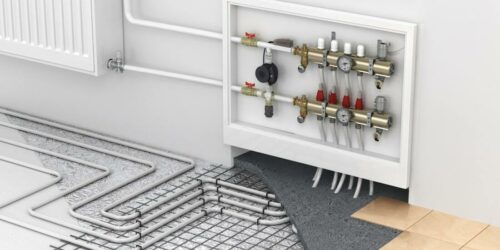Everything You Need to Know About Solar Powered Underfloor Heating
- Solar underfloor heating can be wet or electric
- Compatible with solar thermal and solar PV panels
- Underfloor heating is more energy efficient than using radiators
Just when you thought the benefits of underfloor heating couldn’t get any better, now you find out that it’s compatible with your home renewable system. While solar heating hasn’t been possible with traditional radiators because of their high operating temperatures, solar underfloor heating is the answer and a modern-age solution.
What’s more, you have several options to choose from, both in terms of which underfloor heating you can install and which solar heating system will work. Solar underfloor heating is incredibly diverse and gives you much more flexibility than a traditional radiator system.
In this article, we’ll look at the different options available and break down the important points of solar underfloor heating. From which solar systems are able to operate underfloor heating to which type of flooring works best, all angles are covered.
Ready for solar panels already? Use our quote comparison tool to see how much you'd pay. It only takes a minute.
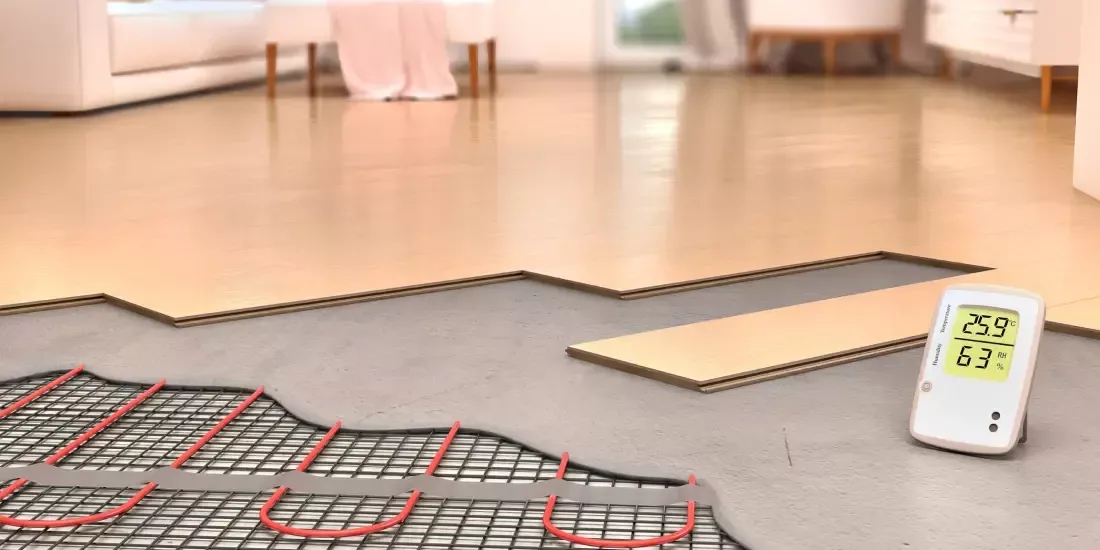
What's On This Page?
Click the links below and head straight to a specific section of the article.
Solar Underfloor Heating: Wet or Electric?
Underfloor heating comes in two options: wet or electric. A wet system is more in line with a traditional radiator system, pumping hot water through a series of continuous pipes embedded in the floor. An electric system, on the other hand, uses electric wires and coils to produce heat beneath the flooring and is powered by electricity.
Solar power can either heat up the electric coils for an instant delivery of heat or work more slowly with a wet underfloor system. The liquid piped underneath the floor will heat up, but as it conducts heat well, it takes much longer to get up to temperature and to distribute it evenly throughout the house. It is much more efficient at doing this than radiators are as more space is used in the process.
The good news is, both solar thermal and solar PV panels can be used for either heating system. Solar panels for underfloor heating can power the electric elements or the thermal store that would be required for a wet system. Likewise, a solar thermal system, which heats water using the sun’s energy, can provide heat to a wet underfloor system. However, solar thermal power is only useful in the summer, which is also when you won’t need your underfloor heating, so we’ll focus mainly on PV solar powered underfloor heating instead.
Solar Panels for Underfloor Heating

The main advantage of solar underfloor heating is that you’ll be living greener with reduced energy costs and fewer carbon emissions. The solar panels themselves use energy from the sun to either power the heating coils in a hot water thermal store, which heats the water used for your wet underfloor heating, or allow your electric underfloor heating to run on the collected electricity.
One of the drawbacks to solar underfloor heating using this method is that the solar panels themselves won’t be able to cover operating costs overnight. The easiest way around this is to make use of solar batteries, which allow you to utilise the energy your panels have captured during the day. As you’re more likely to need to use underfloor heating in the evenings, this would dramatically decrease operating costs.
Operating Your Solar Underfloor Heating
Underfloor heating is so efficient that you generally won’t notice it running. It can be operated at a much lower temperature than radiators and costs a lot less to run. Electric systems tend to operate more quickly, while wet systems need a bit of time to kick in. This is no different for solar underfloor heating.
Generally speaking, you should keep your wet solar underfloor heating running 24/7. This does come with a few caveats though, as you won’t be using the system in the summer and you won’t need the high temperatures all the time. Because wet underfloor heating takes a while to get to temperature, it’s much more efficient to keep it running at a lower temperature the majority of the time. Setting your programmer 4°C lower when your home isn’t occupied and at night will keep your home at optimum efficiency and heating levels, reducing the time it needs to heat up again when required.
It should also be noted that a solar underfloor heating system is not an immediate source of heat. It will generally take at least a couple of hours for any thermostat change to filter through the system. They also work at much lower temperatures than radiators, so you may not even notice them when they’re in operation.
Cost of Solar Underfloor Heating Systems
Installing underfloor heating is a very invasive procedure, which takes time and effort to finish. As such, you can expect labour costs to be quite high. New builds will be planned with underfloor heating in mind, which severely reduces costs. Replacing a heating system is not an easy process, which is why it would cost more to install a new solar underfloor heating system.
Planning to change to solar powered underfloor heating? Have you thought about how many solar panels you would need?
Electric Underfloor Heating Costs
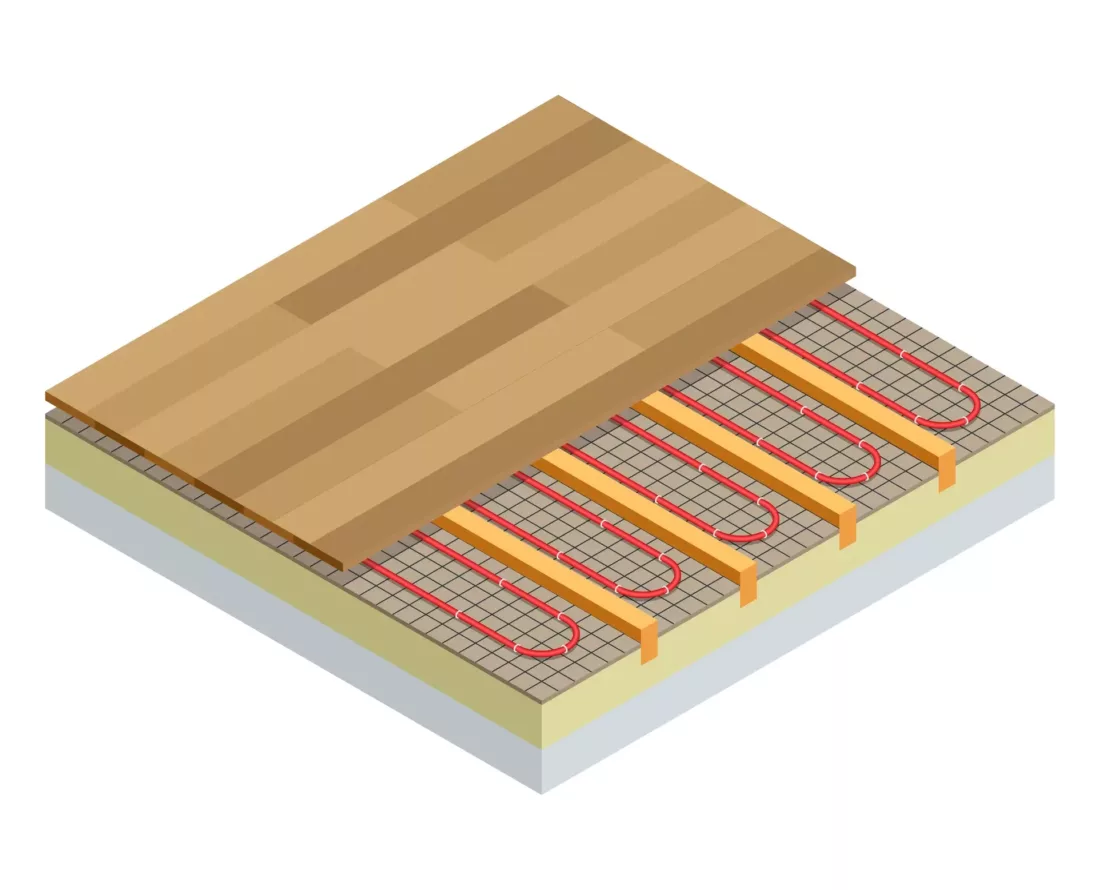
As electric underfloor heating tends to be installed in smaller areas, it works out a lot cheaper than a wet system. Even if you were to replace your whole heating system with electric solar underfloor heating, it will work out cheaper than a wet system. This is because it’s much easier to install.
For a typical 4m² bathroom, for example, you can expect to pay anything from £500 for electric underfloor heating. A larger 10m² bathroom could cost around £800. This can be more if you take into account the use of smart thermostats, which would increase your efficiency.
On top of this, labour costs can be around £200-£300 a day. If you’re only doing a small room, you can expect to not pay much more than this as the installation won’t take as long.
Wet Underfloor Heating Costs
This type of system is more efficient to run, but is tricky to install. Because of all the pipework associated with this solar underfloor heating, installation costs are much higher. Manifolds need to be set up as well, which distribute heat to each zone in the house, so you can’t just rely on flicking a switch as with electric heating.
A typical 10m² room can cost around £1,200 for wet underfloor heating. With a more complex heating system to install comes a longer installation time. With labour costs around £250 a day, this will quickly add up, and if you’re installing this system in more than one room or throughout your home, the costs will escalate.
Energy Efficiency of Solar Underfloor Heating
Wet solar underfloor heating systems are much more energy efficient. They are estimated to use 15-40% less energy than a radiator system, with higher efficiency ratings coming from the use of renewable heating systems, like heat pumps.

Electric underfloor heating is best when it only covers a small area. You don’t tend to see a home running on purely electric underfloor heating as the cost would be unsustainable. This type of heating is usually only used for bathrooms to keep operating costs manageable. 65% of Which? customers even said that they only had electric underfloor heating installed in one room.
Operating costs would be more manageable with a solar panel battery system.
Flooring Type
It’s important to be considerate of the type of flooring you have when it comes to solar underfloor heating. You may have to replace your existing flooring if it’s too thick to allow any heat to pass through. While insulation is placed beneath the underfloor heating system to radiate the heating upwards, unsuitable flooring will reduce the effectiveness of your system and you won’t feel the effects as much.
You’ll need to consider flooring with a high heat transfer. Modern flooring types, including luxury vinyl tiling and ceramic tiles, have a good amount of heat transfer, which allows your home to benefit from solar underfloor heating. Carpets tend to be on the lower end of the scale as they can be too thick to permit heat through; however, you are able to purchase carpets suitable with underfloor heating.
If you have flooring with a low heat transfer, it can trap heat under the flooring, raising the temperature around the solar underfloor heating system and not the room. While this can build and cause damage, in-built thermostats are designed to prevent the underfloor heating from going above a certain temperature.
Pros and Cons of Solar Underfloor Heating
To help break this all down, we’ve provided a quick summary for both electric and wet solar underfloor heating systems below. While they each have their benefits, they also come with drawbacks, including financial and logistical.
Related articles
View all Solar Panel articles
A Complete Guide to Caravan Solar Panels
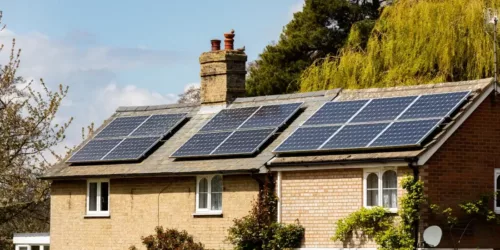
Are Solar Panels Worth It in Wales?

Project Solar UK: Company Overview

Battery Storage for Solar Panels Explained
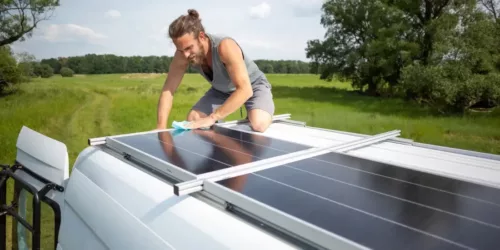
Solar Panel Kits Explained - Everything You Need to Know
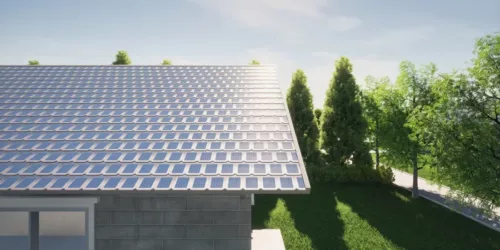
Are Solar Roofing Tiles Worth It?
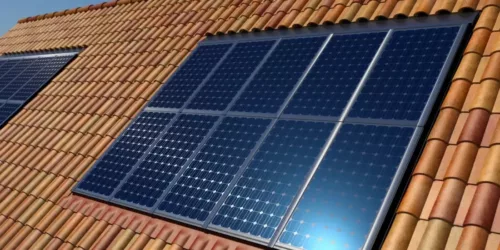
A Complete Guide to Roof Integrated Solar Panels
